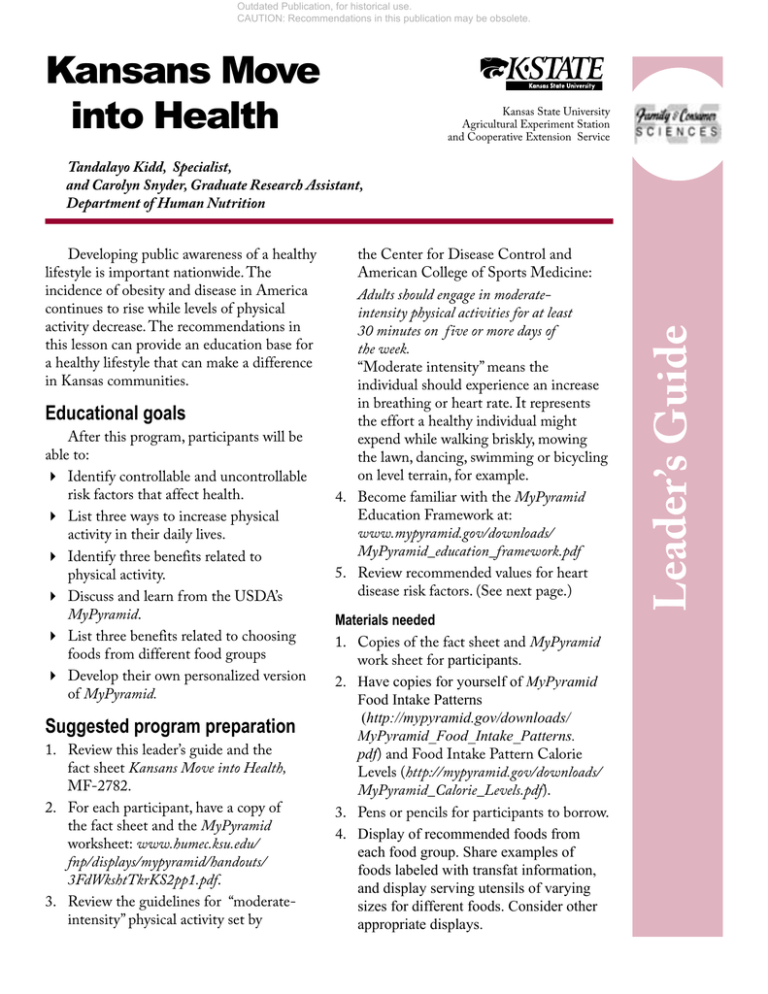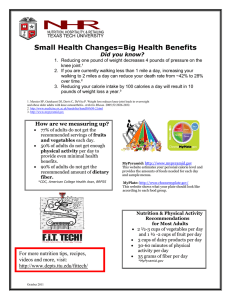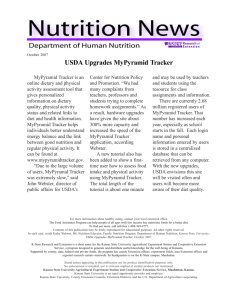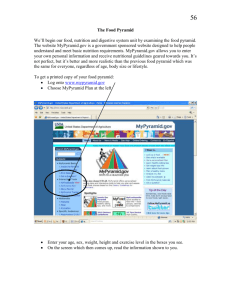
Outdated Publication, for historical use.
CAUTION: Recommendations in this publication may be obsolete.
Kansans Move
into Health
Tandalayo Kidd, Specialist,
and Carolyn Snyder, Graduate Research Assistant,
Department of Human Nutrition
Developing public awareness of a healthy
lifestyle is important nationwide. The
incidence of obesity and disease in America
continues to rise while levels of physical
activity decrease. The recommendations in
this lesson can provide an education base for
a healthy lifestyle that can make a difference
in Kansas communities.
Educational goals
After this program, participants will be
able to:
4Identify controllable and uncontrollable
risk factors that affect health.
4List three ways to increase physical
activity in their daily lives.
4Identify three benefits related to
physical activity.
4Discuss and learn from the USDA’s
MyPyramid.
4List three benefits related to choosing
foods from different food groups
4Develop their own personalized version
of MyPyramid.
Suggested program preparation
1. Review this leader’s guide and the
fact sheet Kansans Move into Health,
MF-2782.
2. For each participant, have a copy of
the fact sheet and the MyPyramid
worksheet: www.humec.ksu.edu/
fnp/displays/mypyramid/handouts/
3FdWkshtTkrKS2pp1.pdf.
3. Review the guidelines for “moderateintensity” physical activity set by
the Center for Disease Control and
American College of Sports Medicine:
Adults should engage in moderateintensity physical activities for at least
30 minutes on five or more days of
the week.
“Moderate intensity” means the
individual should experience an increase
in breathing or heart rate. It represents
the effort a healthy individual might
expend while walking briskly, mowing
the lawn, dancing, swimming or bicycling
on level terrain, for example.
4. Become familiar with the MyPyramid
Education Framework at:
www.mypyramid.gov/downloads/
MyPyramid_education_framework.pdf
5. Review recommended values for heart
disease risk factors. (See next page.)
Materials needed
1. Copies of the fact sheet and MyPyramid
work sheet for participants.
2. Have copies for yourself of MyPyramid
Food Intake Patterns
(http://mypyramid.gov/downloads/
MyPyramid_Food_Intake_Patterns.
pdf) and Food Intake Pattern Calorie
Levels (http://mypyramid.gov/downloads/
MyPyramid_Calorie_Levels.pdf).
3. Pens or pencils for participants to borrow.
4. Display of recommended foods from
each food group. Share examples of
foods labeled with transfat information,
and display serving utensils of varying
sizes for different foods. Consider other
appropriate displays.
Leader’s Guide
Kansas State University
Agricultural Experiment Station
and Cooperative Extension Service
Outdated Publication, for historical use.
CAUTION: Recommendations in this publication may be obsolete.
Heart disease risk factors
Total cholesterol
Less than 200 mg/dL
Desirable level that lowers risk for coronary heart disease.
(A cholesterol level of 200 mg/dL or higher raises risk.)
HDL cholesterol
Less than 40 mg/dL
(for men)
Less than 50 mg/dL
(for women)
Low HDL cholesterol: a major risk factor for heart disease.
60 mg/dL and above
High HDL cholesterol. An HDL of 60 mg/dL and above is
considered protective against heart disease.
LDL cholesterol
Less than 100 mg/dL
Optimal.
Body fat
Waistline 35 inches or more
for women
High Risk.
Waistline 40 inches or more
for men
High Risk.
Systolic - Less than 120mmHg
Normal.
Diastolic – Less than 80mmHg
Normal.
Blood pressure
Suggested program presentation guide
1. Introduce yourself. Give each participant a
pen or pencil and a copy of the fact sheet.
Allow several minutes for each to review
the fact sheet and make notes.
2. Allow at least 30 minutes to teach
the lesson. If possible, answer relevant
audience questions as they arise, rather
than holding all questions for the end of
the program.
3. Begin with answering the question,
“What is health?” on the front page.
What do they define as “healthy”? Ask
what they do in their everyday lives to
increase physical activity. If time allows,
discuss barriers to physical activity.
4. Using the chart at the top of this page,
discuss risk factors for heart disease.
Make sure to provide information on
5.
6. 7.
8.
recommended risk factor values. If there
is time, have participants write down their
risk factors. If they do not know their
values, recommend that they see their
health-care providers. Reinforce the idea
of taking preventive measures, such as
cholesterol and blood pressure tests.
Provide contact information, locations and
dates when participants can sign up for
Walk Kansas.
Discuss MyPyramid with participants.
Assist them in determining their calorie
needs and serving sizes from each food
group for their worksheets. Recommend
that they keep the worksheet on the
refrigerator at home to keep track.
Ask the participants to fill out an
evaluation for the program.
Thank the audience for their participation.
Authors
Tandalayo Kidd, PhD, RD, LPN, Specialist, and
Carolyn Snyder, RD, LD, Graduate Research Assistant,
Department of Human Nutrition, Kansas State University
Reviewers
M. Gayle Price, Professor and Southeast Area Family and Consumer Science Specialist, K-State Research and Extension
Michael H. Bradshaw, Associate Professor and Health and Safety Specialist, Department of Family Studies and Human Services,
Kansas State University
Brand names appearing in this publication are for product identification purposes only. No endorsement is intended, nor is criticism
implied of similar products not mentioned. Publications from Kansas State University are available on the World Wide Web at:
www.oznet.ksu.edu
Publications from Kansas State University may be freely reproduced for educational purposes. All other rights reserved. In either case,
credit Tandalayo Kidd and Carolyn Snyder, Kansans Move into Health, Kansas State University, July 2007
Kansas State University Agricultural Experiment Station and Cooperative Extension Service, Manhattan, Kansas
MF-2783
JULY 2007
K-State Research and Extension is an equal opportunity provider and employer. These materials may be available in alternative formats. Issued in furtherance of Cooperative Extension
Work, Acts of May 8 and June 30, 1914, as amended. Kansas State University, County Extension Councils, Extension Districts, and United States Department of Agriculture Cooperating,
Fred A. Cholick, Director.




